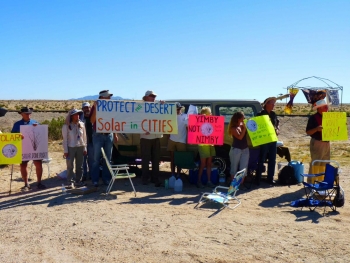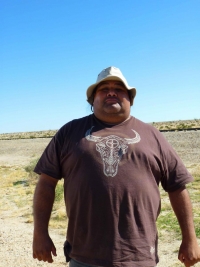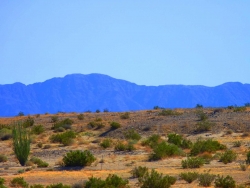Environmentalists, desert enthusiasts and East County organizations also object to Tessera’s 10-mile-long, 6,000-acre desert solar farm which would tie in to Sunrise Powerlink
By  Miriam Raftery
Miriam Raftery
November 17, 2010 (Ocotillo) – “To me, it is a genocide of our tribal ways and culture,” Preston J. Arrow-Weed, a member of the Quechan Native American tribe, told East County Magazine. Gazing out at the Coyote Mountains on ancestral land he considers sacred, he asked, “All this electricity and who gets it? Not us.”
The Quechan Indians filed a lawsuit October 29th against the U.S. Department of Interior seeking to halt the project. On November 15 and 16, a coalition of Indians, environmentalists and desert enthusiasts staged protests at two solar desert sites. In Ocotillo, dozens of protesters hoped to draw public attention to the project’s impacts on the desert ecosytem, cultural resources and a national historic trail.
“This land is culturally significant to the Yaman language speaking families—Kumeyaay, Cocopah, Quechan, Mojave and Hulapai,” explained Alan Hatcher of Lakeside, a Cocopah tribal member. Lake Cahuillo, which once occupied the land, “is really significant to East County,” Hatcher said. The lake served as a stopover for tribes traveling from Arizona to San Diego’s East County for trading purposes. The lake receded about 500 years ago, but cremated bones of tribal ancestors are buried in the earth here. “It’s sacred to us,” Hatcher said.

Secretary of the Interior Ken Salazar announced October 5th that the Imperial Valley project, one of two being built by Tessera and Stirling, was approved and the 709-megawatt concentrated dish solar station would move forward. The other is slated for the Mojave Desert. The two projects will be among the world’s largest solar energy facilities, according to Stirling Energy Systems, producing 1,000 MW of power by 2012.
“These projects are milestones in our focused effort to rapidly and responsibly capture renewable energy resources on public lands,” Salazar said. “These projects advance the president’s agenda for stimulating investment in cutting-edge technology, creating jobs for American workers, and promoting clean energy for American homes, businesses and industry.”
The Tessera Imperial Solar II project, slated to break ground in December, would involve bulldozing 6,000 acres of desert and installing 28,000 “Sun-Catcher” parabolic mirrors over a ten-mile long stretch of desert habitat between I-8 and Evan Hewes Highway east of Ocotillo. Tessera did not return a call from ECM requesting comment for this story.
The mirrors would track the sun, focusing heat on Stirling engines which would power “noisy” turbines, according to Terry Weiner with Solar Done Right. The group wants to see solar installed in urban areas where the energy will be used, such as on rooftops, rather than in desert habitat.

Opponents say the Sun-Catcher technology has never been tested on an industrial scale. “Tessera is using eight months experience with 60 Sun-Catchers in Phoenix to predict 40 years of successful operation of 80,000 Sun-Catchers,” said Tom Budlong, an engineer who intervened in an Imperial solar project with the California Energy Commission. “Only the federal government has agreed to take this risk. Private investors have not.”
Tessera spokesperson Janette Coates provided the following remarks in response to an ECM request for comment.
"Tessera Solar has attempted to take a respectful and responsible approach to siting and permitting the Imperial Valley Solar Project, seeking a way to ensure development of clean renewable energy in a way that minimizes environmental impacts, including cultural resources. Tessera Solar reduced the original project footprint by approximately 1,000 acres to avoid Native American cultural resources. In addition, as we have stated during the course of the environmental review process the BLM and Tessera Solar engaged in a lengthy and thorough consultation with affected Native American tribes and other interested parties that resulted in a comprehensive Programmatic Agreement governing treatment of cultural resources. Under this Programmatic Agreement, Tessera Solar will implement measures to avoid and mitigate impacts to sensitive cultural resources."
But Hatcher and others believe that more needs to be done by Tesssera and the government to address the tribes’ concerns. “It’s on a fast track,” he said of the project. “Just like Powerlink, the public is not aware of the impacts.”

Hatcher added that Tessera is dependant on $250 million in stimulus funding for the project—money he said is largely dependant on breaking ground by December 1st.
“We’re in favor of renewable energy as a human race,” he said, but expressed concern over the desecreation of ancestral lands. “Of course we don’t want it on our sacred land,” he said. Hatcher told a story of seeing a rabbit emerge from a burrow. “That could be one of our elders coming back. It’s as simple as that. It’s a part of our belief,” he said, adding that one elderly tribal woman shed tears at the sight. “We look at this process as removing evidence of our existence here.”
“What we will lose is really diverse lower Colorado River habitat,” said Weiner. The property is under jurisdication of the federal Bureau of Land Management and is critical habitat for Peninsular bighorn sheep, a federally designated endangered species. Numbers have declined sharply in recent years, linked to destruction of habitat.
“I spotted three bighorns here myself on Highway 8,” said Weiner, who said the sheep travel from Coyote Mountains south to the Jacumba Mountains. “The sheep started to be in trouble with building of Highway 8,” she said, noting that the border wall has also prevented the bighorns’ movement into the Juarez Mountains in Mexico. “This is also habitat for badger, mountain lions, coyotes—lots of significant species.”
Kevin Emmerich, a field biologist who formerly served as a park ranger in Death Valley, said herds of bighorn have been seen on this site, which provides both good grazing as well as a pathway for herds to move from one mountain range to another. He fears that industrialization of the area would harm both
“We need to preserve this desert habitat, not industrialize it,” said Laura Cunningham, a herpetologist who contends the project will threaten survival of the flat-tailed horned lizard, a species that has been under consideration for designation as an endangered species. Other habitat areas have already been impacted by housing development, roads and off-road vehicle traffic, environmentalists note.
Tessera has offered to purchase 6,000 acres of additional habitat as mitigation. But Weiner is skeptical whether there is sufficient habitat left. “They’re being allowed to start this project even before identifying property to buy.”
Ingrid Crickmore and her husband, Bob Ellis, are long-time desert hikers and backpackers, as well as members of Desert Survivors, a hiking group that promotes desert conservation. Crickmore criticized “drive by `windshield’ surveys” adding, “They should have gone over it inch by inch.”
Edie Harmon said a staff member at a California Energy committee meeting told her that cultural resource surveys ordinarily take three to five years. “They did this in less than two—not adequate.”
Ellis reflected, “We who live in urban areas need a lot more experience in open space to recharge from the city.”
He voiced outrage that the BLM has approved destruction of a the De Anza National Historic Trail, traveled by early explorer Juan Batista De Anza in 1776 from Mexico to San Francisco. “This project will go totally right over the middle of the national historic trail,” he said. Ellis observed that the BLM “is supposed to manage wilderness areas and national historic trails for the purposes they were designated for, and yet the national office of the BLM decided to put this right over a historic trail.” Greg Smestad, a direct descendant of Batista De Anza, is “very much concerned,” he added, noting that Smestad, who wrote a brochure for the park service, has submitted commentary on the California Energy Commission website opposing the project.
 Donna Tisdale of Boulevard said that a grassroots coalition of East County groups including Protect Our Communities Foundation, Backcountry Against Dumps and the East County Community Action Coalition have approved filing litigation against the IV Solar Project, for which phase II is reliant on Sunrise Powerlink. Details are available at www.protectourcommunities.org.
Donna Tisdale of Boulevard said that a grassroots coalition of East County groups including Protect Our Communities Foundation, Backcountry Against Dumps and the East County Community Action Coalition have approved filing litigation against the IV Solar Project, for which phase II is reliant on Sunrise Powerlink. Details are available at www.protectourcommunities.org.
Arrow-Weed, a singer of ancient tribal songs passed down through generations for thousands of years, has also made documentary films on the significant of this region to his people (Journey from Spirit Mountain and Songs from the Colorado River; the latter will be out in December.) He said the ancient songs are proclamations that prove “the land has been given to us. These proclamations are really why I’m here.”
Gazing out at Mount Signal (known as Eagle Mountain today), he observed, “They made the law. They can twist it if the want to and people who have money can twist it, too.” He said he attended a meeting at a BLM office and voiced his concerns. “I said, 1 don’t care what you want. I don’t want you here. Get out.” Other tribes were there. No one gave consent.”
If solar farms must be built, Arrow-Weed believes California should follow Arizona’s example. “They’re putting them on farmland that has already been impacted,” he said. “Why does BLM want to put it on these lands?”
Enticements of employment are merely short term, and Tessera is apt to bring in mostly their own people, not hire locals, he suspects. “The BLM are the stewards of the land. They should say `No. No!” he emphasized.
 Arrow-Weed’s tribe today lives on a reservation in southeast California close to the Arizona border. For him, preservation of his ancestor’s ancient migration corridor and sacred sites is imperative. The Coyote Mountains, visible from the site, are part of his people’s creation story, as he related in this ECM video. “That was where the coyote took the creator’s heart ,” he said. “Jumped in the fire, took his heart and ran.”
Arrow-Weed’s tribe today lives on a reservation in southeast California close to the Arizona border. For him, preservation of his ancestor’s ancient migration corridor and sacred sites is imperative. The Coyote Mountains, visible from the site, are part of his people’s creation story, as he related in this ECM video. “That was where the coyote took the creator’s heart ,” he said. “Jumped in the fire, took his heart and ran.”
The story is one of many passed down through proclamations from long ago. “Before they wrote the Constitution, before they wrote the Magna Carta, before they came from England with their papers and their Bibles, we already had those songs proclaiming certain areas—what we felt, what we did and what we lived by,” he said.
Beneath the mid-day sun, the tribal elder gazes heavenward and reflects, “I’m 70 years old and I’ve seen a lot of things in my 70 years.” But he concluded, sadness shadowing his face, “I don’t know if anybody will listen to me.”











Comments
solar panels
I know we have the technology. There are lots of ways to convert energy from free resources. Its just that all the big politicians and word leaders are not letting us have it and use it. They intend to make money before handling us the technology.
just another corporate scam
Just another scam in which a corporation, aided by those in power in the government, gets a sweetheart deal. And what a deal, the taxpayer pays for the project, assumes all the risk if it fails, and the corporation takes all the profits. What is new is the speed at which it is taking place and the boldness of the executive branch of the government (lead by a president who promised a change) in ignoring the people's wishes and law.
I hope the pres. starts listening, thinking and living up to his words, or that the lawsuit stops this destruction of the desert and sacred lands. But if all of these corporate mega-solar projects are built instead of putting solar collectors on all of our house and building rooftops, I expect within ten years we will look back on this, see that this was just One Big Ass Mistake America, and realize we were fooled again.
Go Quechan! our land thanks you
Thank goodness the Tribe has drawn attention to the damage these projects will do, and has the moral fortitude to file suit. Policies pushing Big Solar are a disaster, and emblematic of the same old dumb assumption that always victimizes our public land: that it's all just a bunch of empty space crying to be put to use. It's completely unnecessary for any culturally or biologically rich land to be developed for this purpose, as Mr. Arrow-Weed points out. Yet right now there are more than a million acres of public land under application, just for solar. And more to come, as this mistaken policy gathers momentum. We have got to turn this issue around now--putting solar arrays on rooftops, in parking lots, anywhere, everywhere in the built environment. What sense does it make to save the planet from climate change through projects that destroy it piece by piece?
solar project in Imperial Valley
Thank you for the excellent article. You clearly explained opposing points of view. I live in the Imperial Valley and love the area which may soon be marred by 25000 suncatchers. I want to see solar energy developed in our area, but on our rooftops, not on pristine desert. One concern that I believe was not mentioned in the article or comments is dust. Imperial County has serious dust pollution and has one of the highest levels of asthma in the country. The desert surface will be broken in order to build roads between the suncathers and this will greatly increase this problem.
Problems with the Imperial Solar Project
Another characteristic of this and other ‘Fast Track’ desert solar projects is government subsidies and risk assumption. Tessera wants to get 30% of construction costs paid by ARRA stimulus funds. Then it wants the government to provide a Department of Energy loan guarantee for the balance. With this financing, Tessera has transferred substantial cost and almost all risk to taxpayers. Should the project fail, taxpayers will be forced to make good on the guaranteed loan. Tessera can take substantial profit if the project succeeds and negligible loss if it fails. No wonder they want the project so much – opportunity for profit with minimal risk is rare. Private investors are reluctant. Tessera abandoned a small 1,000 SunCatcher project in Texas when it was unable to find financing.
Equally aggravating is rate secrecy. Tessera will sell electricity it generates to San Diego Gas and Electric, who will distribute it to their customers. During the California Energy Commission hearings I asked Tessera for the price they will get from SDG&E for their product – the electricity produced. I was told the contract between Tessera and SDG&E is confidential, and Tessera was bound by the contract not to disclose the contract pricing. I suspect, but have no evidence since the price is a secret, that it is double the current retail price, so by the time SDG&E adds normal distributor markup, people will be paying more than double. If Tessera wants to challenge my estimate of double, I would welcome an answer to my question at the hearings, namely, the pricing structure. The net of this is that we taxpayers are paying a substantial part of the project, taking most of the risk, sacrificing our public land, and we are not allowed to know the cost of what we are buying.
We seem not to be clever enough to encourage solar panels on these roofs to generate power where it is used, eliminating the need for expensive long distance power lines that ruin even more open space and sensitive land and lose 7-10% of the power run through them.
Tessera’s SunCatchers use Stirling engines to convert solar to electricity. This engine was invented almost 200 years ago, has seen some successful applications, but has never been mass produced as Tessera plans to do. It uses hydrogen as the internal working gas, to the extent that the hydrogen on-site is almost as much as was in the Hindenburg dirigible that burned up in New Jersey in 1937. Admittedly, the Hindenburg’s hydrogen was all in one big bag, but it was at atmospheric pressure. The Imperial project will have hydrogen in pressurized tanks, some over 2500 psi, and a large assortment of valves, pipes, regulators and other fittings with a hydrogen line to each of the 25,000 SunCatchers. The amount of machinery involved presents huge opportunities for failure. Still, despite the paucity of field experience, Tessera has plans for 60-80,000 of their SunCatchers in California and other states.
As Preston Arrow-weed pointed out, the site is sacred and precious to his tribe and to others in that desert area. To industrialize it would be similar to putting a solar farm on the Gettysburg battlefield, or the National Mall in Washington DC. During the Energy Commission’s process leading to approval of the site, it was brought out that the Imperial site has more Indian archaeology than all the other Fast Track desert solar projects combined. For historic significance, it is smack astride the trail taken by Juan Batista de Anza and his expedition during his 1772 expedition from Sonora to Alta California. This is a National Historic Trail, supposed to be under protection of the National Park Service.
To build the Imperial solar project is not only tragic, it is an unwise triumph of big over clever.
It's a shame
that this far along in the process, the average person of good will still doesn't get it.
These gigantic solar "farms" will destroy everything they come in contact with. As the previous comments
pointed out, the land is scraped bare, packed down, herbicide and chemicals are sprayed on the soil to hold the dust down and retard plant growth, it's fenced, to keep animals and humans out, and thousands and thousands of these obscene looking suncatchers, btw extremely noisy and unreliable, will be planted in the ground, where they will remain for the next few decades.
This fate to their land, culture, and biological resources was too much for the Quechan people to bear and they have sued in federal court to stop this blasphemy from being perpetrated against the land. I wish them well with their struggle.
Of course if the promoters hadn't been in such a hurry to save a few bucks and the bureaucrats weren't so eager to oblige, perhaps they might have considered an alternate siting on disturbed land for instance. But alas, it was "rush, gotta get those ARRA federal stimulus bucks before they come to their senses" and so we are at this current impasse.
Morongobill
http://morongobillsbackporch.blogspot.com
healthy ecosystems cannot be replaced
Thanks to all who are working hard to both protect our open spaces AND promote clean, sustainable, democratically-owned renewable energy within the built environment.
First, to dispel some mythology - the entire 6 square miles will be bulldozed to the ground, killing EVERYTHING there. There will be no "creatures getting used to it" because they will all be dead, their burrows destroyed, and their food and water non-existent. So, let's stop trying to feel better about this massive act of destruction, and start advocating for REAL renewable energy, which must be defined as non-consumptive power.
You can't kill 6000 acres and every living thing around, emit HUGE amounts of the exact GHGs you are claiming to be reducing, and destroy an aquifer, then pretend you are somehow sustainable. It's ridiculous, so why are people letting the greenwashers get away with it?
The truth is that efficiency, passive heating and cooling and rooftop solar are FAR superior options, both for the environment and the economy. Rooftop solar creates twice as many jobs as Big Solar (3 times as many as Big Wind), it improves property values, requires no new transmission, and does not kill or destroy anything. When supported with the proven policy of "feed in tariffs," it creates a healthy return on investment for regular people like us who invest in clean power production that does not slaughter our wild places, money that is kept in local communities, not offshored to Big Energy conglomerates, AND the power is STILL CHEAPER than both the status quo (fossil fuels) and the Big Solar Boondoggles.
PLEASE know the difference between GOOD SOLAR and BAD SOLAR. This is the latter!
Solar in the city
Follow the money to see why solar installations are being sited in the desert. Average Joe, the plumber, must still purchase his energy from the large energy corporations...there will be NO reduction in costs or savings to you. Only profits for the company, destruction of desert habitat. Putting solar on Native peoples sacred sites would be the same as putting it in white mans sacred sites...except we would not allow that to happen. Would you like to see solar site on top of a cemetary?
Why not put solar on rooftops and other facilities in the developed areas. Instead of big corporate handouts to the solar companies, how about a 'real' tax break to your average Joe to encouage solar on the rooftop. Once its paid off...FREE ELECTRICITY!! This would create jobs in the city where they are needed, for small solar businesses.
Suncatchers
I AM listening to you, Mr. Arrow-Weed, but what is the alternative to these renewable resources? Will the land truly be less sacred if it has these things on it? The land endures. What would be a real disaster is if they found coal or oil below the land. The animals will get used to the new things and continue on their way, doing as they have always done in most cases but there are so few places that have the space to enable these projects and the human race (not just indigenous peoples) need energy that doesn't come from the burning of fossil fuels. This practice is killing EVERYTHING. Not just a beautiful mountain lion, but a lowly bee or worm - each vital to the continued survival of everything else.
I mourn for your pristine land - but what can we, as a human being, do instead?
Be safe, take care and good fortune,
Patricia